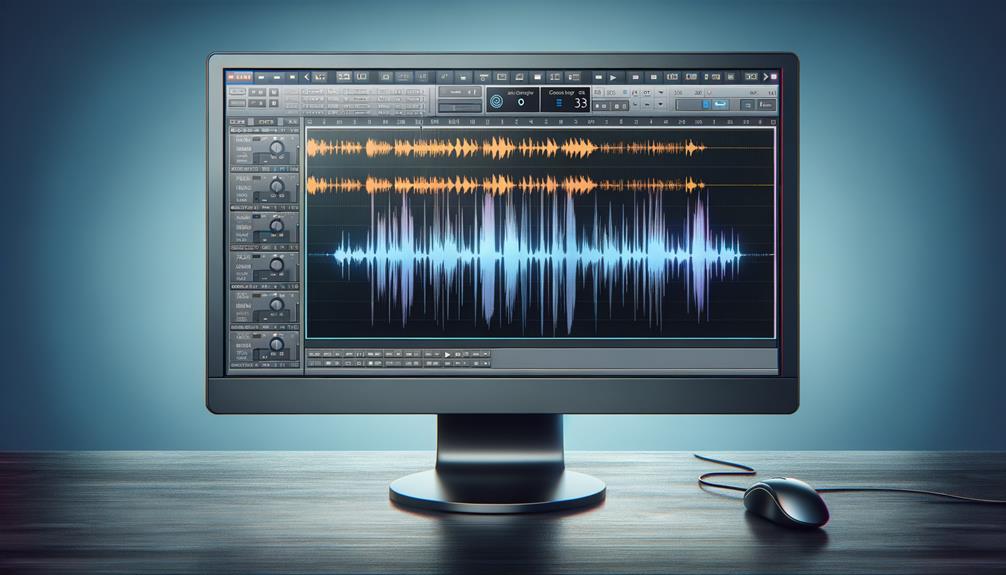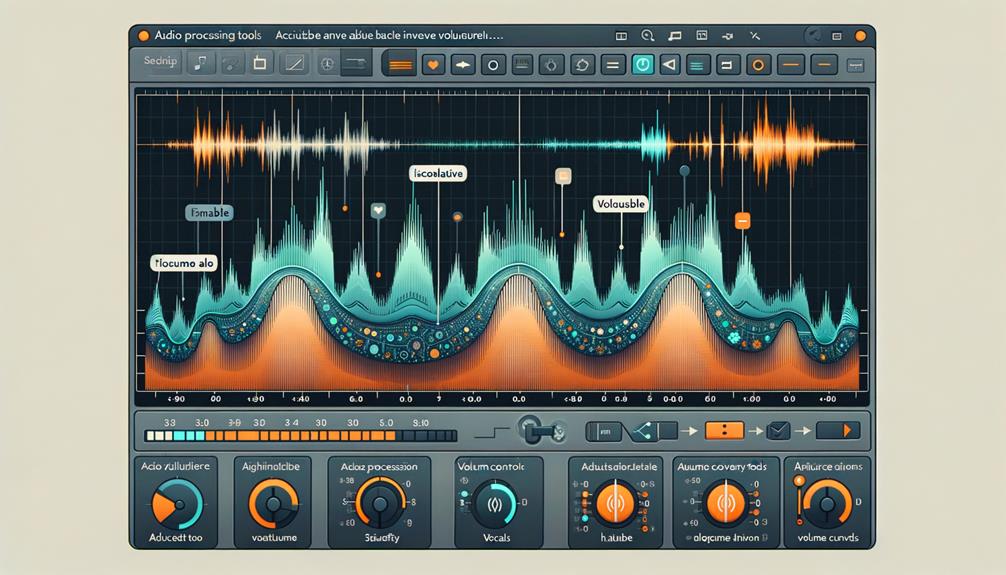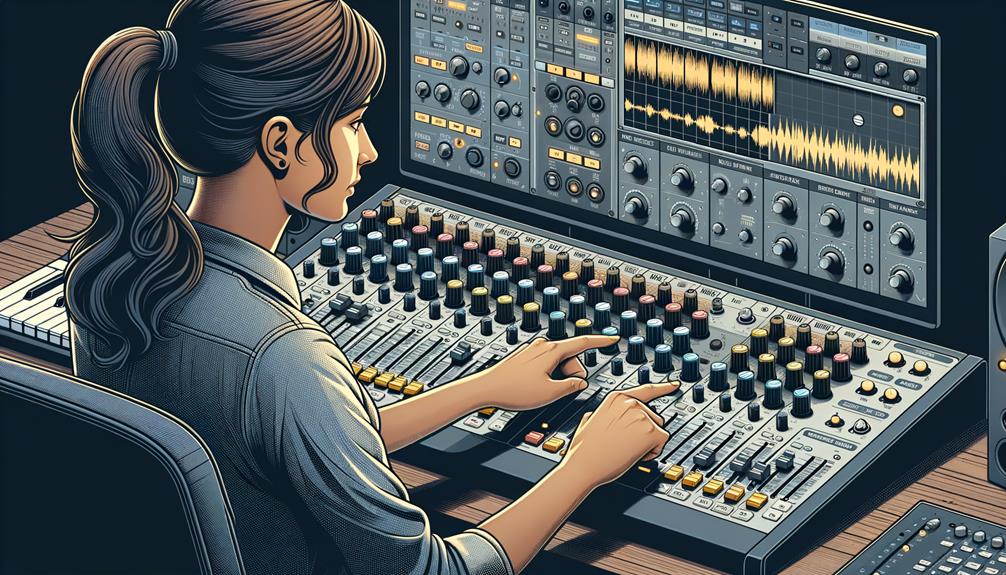No products in the cart.
If you’ve ever tried to isolate vocals in Audacity, you know it can be as tricky as finding a needle in a haystack. But fear not, there are techniques that can help you achieve this elusive feat.
By following a few simple steps and using the right tools, you can separate vocals from the rest of the audio like a skilled surgeon.
So, if you’re ready to unlock the secrets of vocal isolation and take your audio editing skills to the next level, let’s dive in and demystify the process together.
Contents
hide
Key Takeaways
- Vocal removal in Audacity can be achieved using various techniques such as vocal reduction tools, splitting audio channels, and using instrumental tracks.
- The process involves importing the audio file, manipulating the channels separately, selecting the vocal portion, applying vocal reduction and isolation effects, and adjusting the phase inversion and equalization.
- Additional techniques and effects like noise reduction, compression, gating, and de-essing can be experimented with for better results.
- Troubleshooting and fine-tuning involve adjusting amplification levels, minimizing background noise, fine-tuning effect settings, and checking for audio clipping.
Vocal Removal With Vocal Reduction Tool
To remove vocals using the Vocal Reduction and Isolation effect in Audacity, follow these steps:
- Import your audio file into Audacity.
- If the track is stereo, split it to mono to manipulate the channels separately.
- Select the portion of the audio containing the vocals.
- Navigate to the ‘Effect’ menu and choose ‘Vocal Reduction and Isolation.’
- Experiment with different options such as ‘Remove Center Classic (Mono)’ or ‘Remove Vocals’ for stereo tracks.
- Adjust the frequency range to prevent the removal of center-panned bass, hi-hat, or reverb when removing vocals. Be cautious, as this may affect other elements.
- Total vocal isolation may not always be achieved, as it depends on the original recording’s engineering.
- To improve results, try removing background noise before applying the vocal isolation effect.
- Always remember to experiment with different settings and frequency ranges to achieve the best possible outcome.
- This process requires precision and attention to detail, but with practice, you can master the art of vocal isolation in audio editing.
Vocal Removal by Splitting Audio Channels
For isolating vocals in Audacity, consider splitting the audio channels to manipulate them separately and achieve more precise vocal removal.
To start, open the audio track containing the vocals in Audacity. Then, navigate to the ‘Tracks’ menu and select ‘Stereo Track to Mono.’ This action will create two separate mono tracks, one for the left channel and one for the right channel.
After splitting the stereo track, select one of the mono tracks and apply the ‘Invert’ effect from the ‘Effect’ menu. Inverting one of the channels will help cancel out any audio that’s identical in both channels, such as the instrumental background music, leaving only the vocals.
Next, play back the audio to ensure that the vocals are isolated. If needed, adjust the balance and volume of the mono tracks to fine-tune the vocal removal.
This method allows you to manipulate the audio channels separately, providing more control and precision in isolating vocals from a stereo track.
Vocal Isolation Technique Using Audacity

After splitting the stereo track and utilizing the ‘Invert’ effect to cancel out identical audio from both channels, the next step in the vocal isolation technique using Audacity involves fine-tuning the balance and volume of the mono tracks for a more precise removal of vocals.
- Adjust the Phase Inversion: Ensure that the phase inversion is correctly applied to the audio tracks to effectively cancel out the center-panned vocals.
- Use Equalization: Apply equalization to the mono tracks to emphasize vocal frequencies and suppress instrumental frequencies.
- Apply Noise Reduction: Utilize Audacity’s noise reduction tool to further diminish any remaining background music or noise that may interfere with the isolated vocals.
- Experiment with Effects: Try using different effects such as compression, gating, or de-essing to enhance the clarity of the isolated vocals.
- Fine-Tune the Balance: Continuously adjust the balance and volume of the mono tracks while monitoring the isolated vocals to achieve the best possible result.
Using an Instrumental Track for Vocal Isolation
Consider utilizing an instrumental track to isolate vocals by exploiting the distinct positioning of vocals and instruments within the stereo mix. When using a stereo track with vocals in the middle and instruments spread around, the dual mono result can be exploited for vocal isolation.
To achieve this in Audacity, follow these steps:
- Import the original recording and split it into two mono tracks.
- Use the ‘Make Stereo Track’ option from the Tracks dropdown menu to create a stereo track.
- Invert one of the channels to cancel out the audio that’s common to both channels, ideally leaving the vocals.
- Experiment with different settings and techniques as success varies based on the positioning and frequency content of vocals.
- It’s essential to understand that different tracks may require different methods for maximum attenuation or isolation.
- For more advanced techniques, consider using the experimental version of Audacity to explore AI models for vocal isolation.
Troubleshooting Sound Volume


If you find that the sound becomes very quiet after isolating vocals, utilize the Amplify effect and set it to a negative level to increase the volume without distortion.
To troubleshoot sound volume issues when isolating vocals in Audacity, consider the following:
- Experiment with the Amplify effect: Adjust the amplification level to boost the overall volume of the remaining audio after vocal isolation.
- Utilize the Noise Reduction tool: Use Audacity’s Noise Reduction tool to minimize background noise, which can help enhance the clarity and volume of the isolated vocals.
- Fine-tune the Reduction and Isolation effect settings: Adjust the strength, low cut, and high cut parameters to optimize vocal removal and isolate the vocals more effectively.
- Consider alternative software: If the vocal removal techniques in Audacity aren’t yielding satisfactory results, explore alternative software options such as Notta Online Vocal Remover for better outcomes.
- Check for audio clipping: Ensure that the amplified audio doesn’t exceed the maximum volume level, which can lead to distortion. Use Audacity’s built-in tools to monitor and prevent clipping.
Frequently Asked Questions
How Do I Isolate One Voice in Audacity?
To isolate one voice in Audacity, use vocal isolation techniques such as frequency isolation, audio separation, and noise reduction. Apply Audacity’s sound editing tools for vocal extraction, equalization tips, and vocal enhancement to manipulate the audio.
Can I Separate Vocals From Music in Audacity?
Yes, you can separate vocals from music in Audacity using vocal extraction techniques. By employing audio editing methods and sound separation tools, you can isolate vocals, remove music, and enhance the vocals with noise reduction and pitch correction.
How Do You Isolate Specific Vocals?
To isolate specific vocals, explore vocal isolation techniques using Audacity vocal editing. Experiment with audio separation methods and vocal extraction tips. Manipulate the vocal track, enhancing and isolating vocals for music production tricks and vocal enhancement strategies.
How Do I Clean up Vocals in Audacity?
To clean up vocals in Audacity, start by applying noise reduction and equalization techniques. Utilize pitch correction and compression methods for vocal enhancement. Experiment with microphone placement and reverb reduction. Lastly, employ vocal isolation and mixing for optimal results.
Conclusion
In conclusion, isolating vocals in Audacity can be achieved using the Vocal Reduction and Isolation effect.
By adjusting the Strength, Low Cut, and High Cut settings, you can customize the level of vocal isolation to suit your needs.
Keep in mind that the success of vocal isolation may vary depending on the original recording, but with the right tools and techniques, you can effectively isolate vocals in Audacity.




